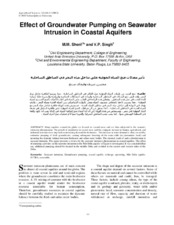| dc.description.abstract | Many aquifers around the globe are located in coastal areas and are thus subjected to the seawater
intrusion phenomenon. The growth of population in coastal areas and the conjugate increase in human, agricultural, and industrial activities have imposed an increasing demand for freshwater. This increase in water demand is often covered by extensive pumping of fresh groundwater, causing subsequent lowering of the water table (or piezometric head) and upsetting the dynamic balance between freshwater and saline water bodies. The classical result of such a development is seawater intrusion. This paper presents a review for the seawater intrusion phenomenon in coastal aquifers. The effect of pumping activities on the seawater intrusion in the Nile Delta aquifer of Egypt is investigated. It was concluded that any additional pumping should be located in the middle Delta and avoided in the eastern and western sides of the Delta. | en |


